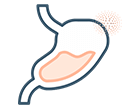Hereditary Hemochromatosis
Hereditary hemochromatosis is a condition that results from the body storing an excess of iron. The excess iron is stored in different body organs causing iron overload.


Hereditary hemochromatosis is a condition that results from the body storing an excess of iron. The excess iron is stored in different body organs causing iron overload. This is harmful because the body can only excrete a certain amount of iron, the iron that is not excreted remains in the body and becomes toxic.
The organs involved are the liver, heart, pancreas, pituitary, joints, and the skin. There are different types of hemochromatosis that can affect individuals of different ages, all types are inherited in an autosomal recessive manner.
The Igenomix Hereditary Hemochromatosis Precision Panel can be used to make a directed and accurate differential diagnosis of iron overload, ultimately leading to a better management and prognosis of the disease. It provides a comprehensive analysis of the genes involved in this disease using next-generation sequencing (NGS) to fully understand the spectrum of relevant genes involved.
The clinical utility of this panel is:
Katsarou, M. S., Papasavva, M., Latsi, R., & Drakoulis, N. (2019). Hemochromatosis: Hereditary hemochromatosis and HFE gene. Vitamins and hormones, 110, 201–222. https://doi.org/10.1016/bs.vh.2019.01.010
Pietrangelo A (2006). Hereditary hemochromatosis. Biochimica et biophysica acta, 1763(7), 700–710. https://doi.org/10.1016/j.bbamcr.2006.05.013
Gerhard, G. S., Paynton, B. V., & DiStefano, J. K. (2018). Identification of Genes for Hereditary Hemochromatosis. Methods in molecular biology (Clifton, N.J.), 1706, 353–365. https://doi.org/10.1007/978-1-4939-7471-9_19